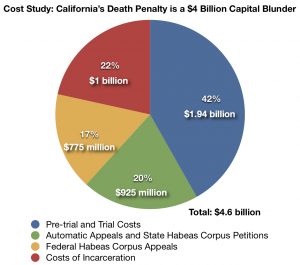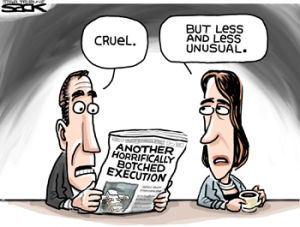As one of the only Western nations that still condones the death penalty, and the most developed to do so, it is clear America’s espoused values of liberty and equality are not represented in capital punishment. Attorney Bryan Stevenson explains “the true measure of our character is how we treat the poor, the disfavored, the accused, the incarcerated and the condemned” (Stevenson 17). This rings true for even America’s most violent criminals, whose humanity deserves to be recognized and who are worthy of mercy.
Positive Outcomes if the Death Penalty is Abolished
- Lower Costs
- A life sentence is less expensive than executing someone due to legal costs, increased expenditures on death row housing, and costs of the execution procedure itself. A 2014 Kansas study indicated that a death penalty case costs nearly four times as much to defend and more than three times as much to prosecute than does a case where the death penalty was not sought (Kansas Judicial Council). Even considering instances where a guilty plea was agreed to and no trial took place, “those cases where the death penalty was sought still cost about twice as much as those where death was not sought” (Erb).
- Appeals increase these costs further. Due to the severity of the punishment and its irreversible nature, appeals are common and often lengthy. The state of New York estimates that one capital case costs about $1.8 million considering only the trial and first appeal (Erb).
- Additionally, the costs of incarcerating death row prisoners greatly exceed that of the regular prison population due to a need for additional guards and a private cell. In California, for example, it costs the state $90,000 more to house a death row inmate annually as compared to other prisoners (DPIC).
- Finally, The costs of lethal injection drugs have skyrocketed due to a limited supply from pharmacies in response to ethical complaints. The price for one component of Virginia’s three-drug cocktail used in executions was 63 times greater in 2016 than it was in 2015 (Richer). The money states could save–reflected in the high costs of capital cases, death row housing and injection drugs– if they no longer had the death penalty is just one advantage of abolishing it.

Source: https://deathpenaltyfacts.wordpress.com/the-cost-of-the-death-penalty-3/
- Less Harm to Individuals and Families
- In addition to the financial burden taxpayers shoulder when it comes to capital punishment, people at all stages of the criminal process are emotionally harmed by executions. This harm could be easily avoided if capital punishment were no longer applied. Executioners are often the most unexpected victims of the harm the death penalty can cause. Virginia state executioner Jerry Givens explains “You can’t tell me I can take the life of people and go home and be normal. If I had known what I’d have to go through as an executioner, I wouldn’t have done it” (Nelson). Eradicating the death penalty would mean no person would ever have to live with the pain of knowing they executed someone.
- A study (described in detail on the Counterarguments page) conducted in Minnesota and Texas examined the effects of Life without parole sentences as opposed to death sentences on healing victims’ families. Texas is a death state, while Minnesota gives life without possibility of parole. Their findings indicated that families in Minnesota were psychologically and physically more healthy than those in Texas following resolution of the punishment (Marilyn). This suggests that life without parole sentences offer more closure and less pain than capital sentences.
Consequences if Capital Punishment Persists
- Conditions of Death Row Inmates
- One enormous consequence of continuing to practice the death penalty is if the practice prevails, 2,817 people will either be executed by their respective states or spend the rest of their lives in inhumane conditions on death row (DPIC). In 18th century America when the U.S. Constitution was written, convicted capital defendants would be executed within days or weeks. Today, many prisoners have spent upwards of 20 years on death row. During this time, inmates spend up to 23 hours a day alone in their cells, are not permitted to attend programs offered to non-death row inmates, and typically exist in solitary confinement (DPIC).
- Some prisoners even begin to exhibit so called “death row syndrome,” a psychological phenomenon where the physical and emotional circumstances of being on death row lead the individual to suffer mental illness. There are a spectrum of symptoms associated with it, from severe anxiety to total psychosis (Schwartz). Michael Ross, a Connecticut man who confessed to eight killings during the 1980s, had become so distraught during his time in prison that his execution was stopped so his competency could be examined. Ross had waived his right to appeal his conviction and attempted suicide three times while incarcerated. Attorneys began to question if it was the condition of death row itself that led him to accept his own execution. Ross wrote in a letter before his death that “the truth is I was driven more by a desire to end my own pain than out of any noble cause” (Tuccitto).
- The most obvious, and foremost consequence of continuing the practice of capital punishment is the fate of 2,817 inmates, who will either be killed or subjected to torturous conditions for the rest of their lives on death row.

Source: https://deathpenaltyinfo.org/time-death-row
- Problems with Executions
- Issues of botched executions, access to lethal injection drugs, and incompetence of executioners are all weaknesses in the practice of the death penalty.
- Austin Sarat, author of Gruesome Spectacles: Botched Executions and America’s Death Penalty estimates that 3.1% of all executions in America beginning in 1890 have been botched in some way. The method of lethal injection specifically has an error rate of over 7% (Miller). This is particularly troubling as it is the most widely used method of execution in the United States today.
- In lethal injections, executioners often have a hard time finding a vein, as they did most recently in February of this year when Doyle Hamm was unable to be executed after 2.5 hours were spent and twelve puncture marks were made trying to find a vein. The Alabama man suffered from carcinoma and lymphatic cancer, but the executioners proceeded despite warnings they would not be able to find a vein (Expert Report of Dr. Mark Heath). The process was ultimately stopped.
- Further, legal obstacles instituted by the Department of Justice and FDA have recently made importation of some lethal injection drugs illegal. This has culminated in “legally dubious activities” on the part of states like Arizona, Nebraska and Texas, who have continued their importation of these drugs (Pilkington).
- Issues of lethal injection and botched executions are complicated when one considers the incompetence and unqualified nature of executioners. Because the hippocratic oath prevents doctors from doing harm, they cannot be involved in executions. This means despite the fact that lethal injections entail medical procedures, these are not being performed by qualified physicians.

Source: https://www.laprogressive.com/botched-execution/
